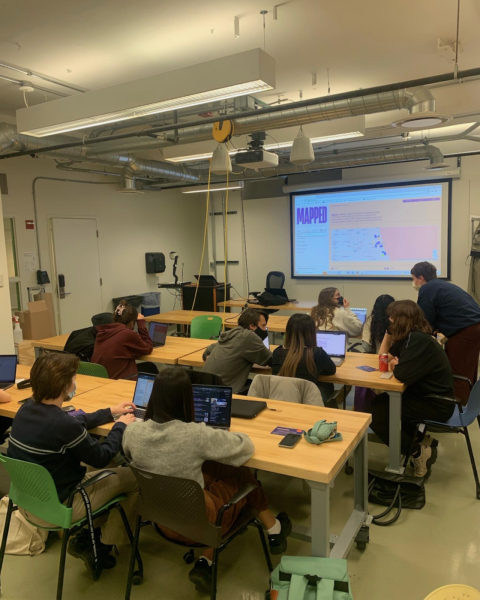The Organization…
Design Trust Chicago is a multidisciplinary civic impact design organization that partners with local leaders and communities to collectively envision an equitable built environment through the design of healthy, vibrant, safe, and thriving spaces and places for all Chicagoans.
*Featured Image: Design Trust Chicago staff (L-R): Emma Jasinski, Katherine Darnstadt, Paola Aguirre Serrano, Elle Ramel, and Clio Lyons
The Project…
MAPPED (Making A People’s Pathway for Engaging Design)
Location: Online
The MAPPED Community Design Summit Series is a collection of localized community gathering events across the city, focused on exploring spatial justice and equity in the built environment, design transparency as a change agent, and innovative approaches to community storytelling and communicating design.
MAPPED, is a digital library dedicated to documenting Chicago’s community projects–built, envisioned, or planned. This public platform showcases resources for communities to advance their design and planning initiatives by mapping ideas, projects, people, plans, and organizations. MAPPED users can quickly access budgets, designers, funders, partners, technical information, and other project specifics that can help them better predict costs and concerns and explore community-focused design possibilities throughout Chicago. By building an incremental map that is populated by and accessible to all Chicagoans, we have increased awareness across the public and design communities towards different design initiatives by providing access to the vital information that make those initiatives work. More about MAPPED
Mapped Website
Follow Design Trust Chicago: Website | Instagram | Twitter | Facebook
The Q&A…
Interview with Clio Lyons, Design Trust Chicago’s Operations Manager, and Emma Jasinski, Design Trust Chicago’s Community Designer.
Q: How do you see the arts/culture/humanities as being essential?

Clio Lyons: Our team often discusses community storytelling, especially in regards to the MAPPED project. In uncovering the best methods to tell the legacy of a community or a neighborhood, I think there are hard facts, like dates and timelines, that provide one subset of information. But I think the greatest understanding of a community’s journey is through the art that reflects their lived experience. Without an understanding of the evolution of artistic expression in a community, it’s impossible to get the clearest view of that snapshot of history, and the legacy that exists therein.
Emma Jasinski: We have recently been exploring how our work exists within the worlds of arts, culture, and the humanities. It is definitely in partnership with the built environment, design, and architecture–and yet what category do we fit into? The beauty of our work is that it is expansive and incorporates all of those elements. We see ourselves as more of a container–for these other fields or areas of work, including arts and culture. I think it’s great because we have the opportunity to work in collaboration with organizations and artists that are providing the majority of public art to their community. I think it’s important that our field, and the work we are doing, is in conversation with the arts, culture, and humanities.
Q: What is the most important thing people should know about your work?
Clio Lyons: All of our projects, initiatives, and advocacy work are centered around increasing accessibility to design. Both in terms of providing access to technical assistance and affordable services, but also bringing the end-user to the center of the design process. By engaging in frequent community workshops and allowing those most affected by a particular project to be as much a part of the design process as a capital ‘D’ designer would be. We are broadening the definition and scope of a designer. Our work is primarily concerned with erasing the notion that you need years of schooling or a technical degree in order to be a designer or be an integral collaborator on a project.
Emma Jasinski: In expanding the definition of designer, we hope that more people will be exposed to design processes. Design shouldn’t solely be housed in an institution. It belongs to the masses. We aim to prepare our clients and partners to go beyond our engagement scope and successfully tackle the next phase of their project’s development. To achieve this, we have developed a collaborative design process that places the end users of a project at the center and builds capacity for them to autonomously carry out future work.
At Design Trust Chicago, we see our organization as evolving into a Chicago community design center. That is a resource model and precedent already established in other cities across the U.S., and they have been around for over 20 years. It’s honestly shocking that a city as large as Chicago–especially considering its rich history of architecture and design–doesn’t have this sort of centralized resource. Our organization’s co-founders, through their own work and by being in conversation with the national design landscape, wanted to bring this sort of robust community design program to Chicago. In regards to partnerships, we have been in conversation with our peers doing similar work in Detroit, Baltimore, New York City, and L.A. to understand how they’ve been successful in their efforts and how we can apply similar approaches to Chicago.
Q: How did you arrive at doing what you do?
Clio Lyons: My formal educational pursuits were more focused on the humanities, and I received my Bachelor of Arts in Government from Dartmouth College, initially planning to pursue a career in Law. I ultimately decided against that, and after graduating, I began working for a major architecture firm in Chicago as a member of the operations team. While it was a very glamorous environment to work in, I became a bit disillusioned by the organizational priorities–often over-focusing on project aesthetics, rather than on the community impact of the work. I then worked for a real estate startup where I gained an appreciation for the entrepreneurial energy and all-hands-on-deck approach to building something new that inherently exists in an emerging organization, like Design Trust Chicago. I knew I wanted to combine that kind of team environment with high-impact community initiatives. Once I became aware of Design Trust Chicago, I knew it would be the perfect place for me to learn and grow.
Emma Jasinski: I earned my Masters in Architecture at Tulane University. That architectural program has been dedicated to efforts of spatial rebuilding in post-Katrina New Orleans. I was exposed to studios and programs that had programs similar to what we are offering at Design Trust Chicago, including an RFP process for not-for-profits and community partners to apply to the architectural center for various pro bono design projects. I worked with a not-for-profit organization doing sanitation work in India–my first exposure to not-for-profit work and community development through a community health lens. I also worked on cross-disciplinary teams, not just with designers and architects. That was especially exciting for me! Since coming to Chicago, I’ve worked at firms doing affordable, multi-family housing and out-patient clinics. I’ve also collaborated on various projects focused on developing domestic violence shelters in California. Working at a multidisciplinary community-centric design organization like Design Trust Chicago seemed like the perfect next step in my career.
Q: Who makes your work possible?
Clio Lyons: That is definitely a multi-part answer! Firstly, our funders–our organization wouldn’t exist without seed funding from the Builders Initiative and the Chicago Community Trust as well as project-specific funding from Illinois Humanities and the Graham Foundation. This philanthropic support system has been crucial for allowing us to sustain our core programs. The brain trust that exists between our team, our organization’s co-founders, and the various networks that DTC is a part of has been wonderful to cultivate and utilize. We’re constantly communicating with other organizations doing similar work to gather information and explore lessons learned. Harnessing that collective knowledge from across our DTC friends and collaborators has been one of the most important aspects of our success.
Emma Jasinski: The planning and development leaders of Chicago see the need for more affordable design programs in Chicago and have recognized Design Trust Chicago’s efforts to close this accessibility gap. It’s now time to have thoughtful conversations about how we make community design programs sustainable and build a constellation of citywide supporters for these initiatives to iterate and grow.
Suggested Reading:
- Emergent Strategy: Shaping Change, Changing Minds by Adrienne Maree Brown
- Deem journal
- Finding Our Way with Prentis Hemphill
About The Illinois Humanities Grantee Partner Spotlight
Illinois Humanities highlights the work of our Community Grants program partners through our “Grantee Spotlight.” It shines the light on our grantee partner’s work, offering details about the organization and the funded project, as well as a Q&A with a team member at the organization. More: ILHumanities.org/Spotlight
About Illinois Humanities
Illinois Humanities, the Illinois affiliate of the National Endowment for the Humanities, is a statewide nonprofit organization that activates the humanities through free public programs, grants, and educational opportunities that foster reflection, spark conversation, build community and strengthen civic engagement. We provide free, high-quality humanities experiences throughout Illinois, particularly for communities of color, individuals living on low incomes, counties and towns in rural areas, small arts and cultural organizations, and communities highly impacted by mass incarceration. Founded in 1974, Illinois Humanities is supported by state, federal, and private funds.
Learn more at ilhumanities.org and on Facebook, Twitter, Instagram, and LinkedIn @ILHumanities.
